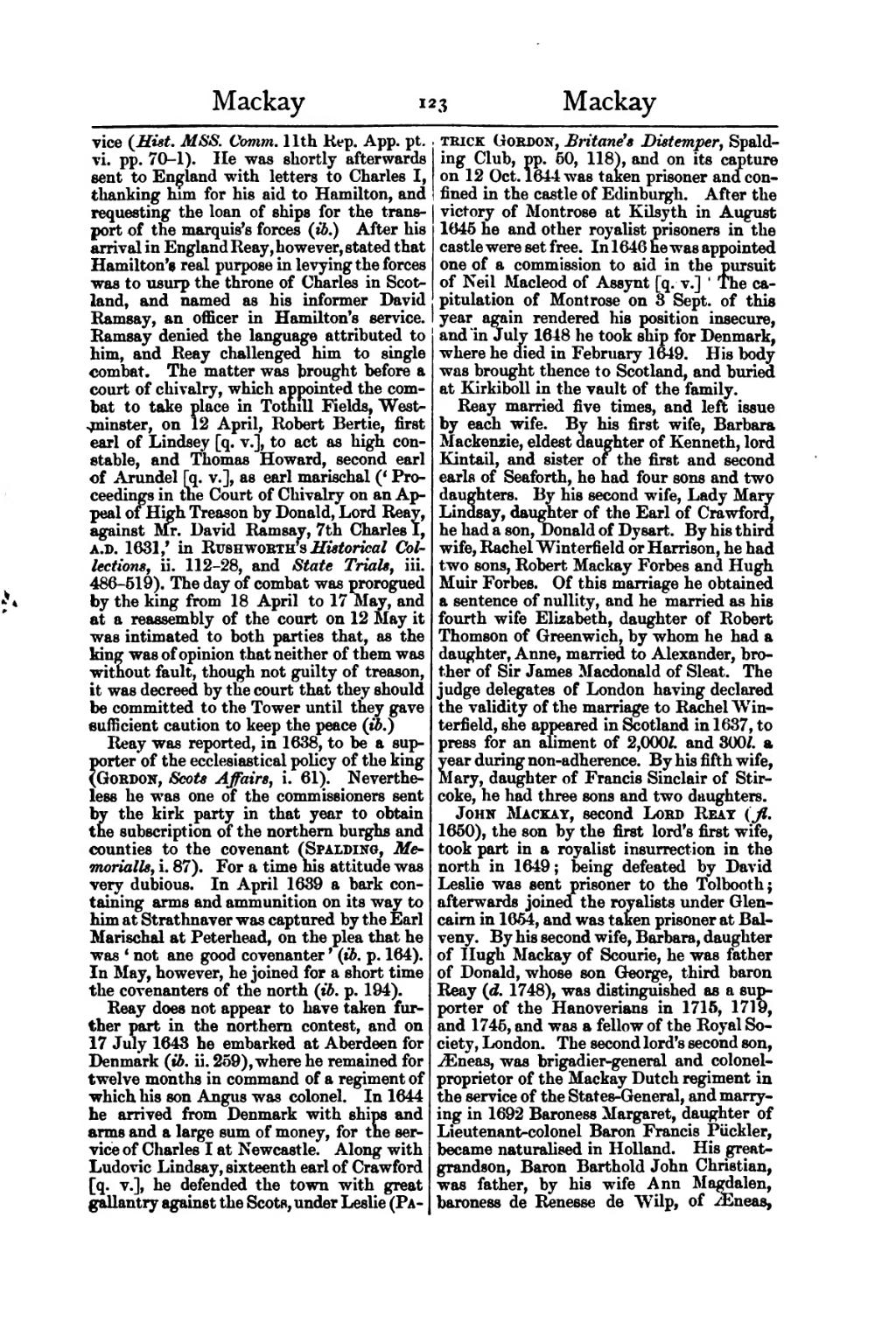vice (Hist. MSS. Comm. 11th Rep. App. pt. vi. pp. 70-1). He was shortly afterwards sent to England with letters to Charles I, thanking him for his aid to Hamilton, and requesting the loan of ships for the transport of the marquis's forces (ib.) After his arrival in England Reay, however, stated that Hamilton's real purpose in levying the forces was to usurp the throne of Charles in Scotland, and named as his informer David
Ramsay, an officer in Hamilton's service.
Ramsay denied the language attributed to
him, and Reay challenged him to single
combat. The matter was brought before a
court of chivalry, which appointed the combat to take place in Tothill Fields, Westminster, on 12 April, Robert Bertie, first earl of Lindsey [q. v.], to act as high constable, and Thomas Howard, second earl of Arundel [q. v.], as earl marischal ('Proceedings in the Court of Chivalry on an Appeal of High Treason by Donald, Lord Reay, against Mr. David Ramsay, 7th Charles I, a.d. 1631,' in Rushworth's Historical Collections, ii. 112-28, and State Trials, iii. 486-519). The day of combat was prorogued by the king from 18 April to 17 May, and
at a reassembly of the court on 12 May it
was intimated to both parties that, as the
king was of opinion that neither of them was
without fault, though not guilty of treason,
it was decreed by the court that they should
be committed to the Tower until they gave
sufficient caution to keep the peace (ib.)
Reay was reported, in 1638, to be a supporter of the ecclesiastical policy of the king (Gordon, Scots Affairs, i. 61). Nevertheless he was one of the commissioners sent by the kirk party in that year to obtain the subscription of the northern burghs and counties to the covenant (Spalding, Memorialls, i. 87). For a time nis attitude was very dubious. In April 1639 a bark containing arms and ammunition on its way to him at Strathnaver was captured by the Earl Marischal at Peterhead, on the plea that he was 'not ane good covenanter' (ib. p. 164). In May, however, he joined for a short time the covenanters of the north (ib. p. 194).
Reay does not appear to have taken further part in the northern contest, and on 17 July 1643 he embarked at Aberdeen for Denmark (ib. ii. 259), where he remained for twelve months in command of a regiment of which his son Angus was colonel. In 1644 he arrived from Denmark with ships and arms and a large sum of money, for the service of Charles I at Newcastle. Along with Ludovic Lindsay, sixteenth earl of Crawford [q. v.], he defended the town with great gallantry against the Scots, under Leslie (Patrick Gordon, Britane's Distemper, Spalding Club, pp. 50, 118}, and on its capture on 12 Oct. 1644 was taken prisoner and confined in the castle of Edinburgh. After the victory of Montrose at Kilsyth in August 1645 he and other royalist prisoners in the castle were set free. In 1646 he was appointed one of a commission to aid in the pursuit of Neil Macleod of Assynt [q. v.] 'The capitulation of Montrose on 3 Sept. of this year again rendered his position insecure, and in July 1648 he took ship for Denmark, where he died in February 1649. His body was brought thence to Scotland, and buried at Kirkiboll in the vault of the family. Reay married five times, and left issue by each wife. By his first wife, Barbara Mackenzie, eldest daughter of Kenneth, lord Kintail, and sister of the first and second earls of Seaforth, he had four sons and two daughters. By his second wife, Lady Mary-Lindsay, daughter of the Earl of Crawford, he had a son, Donald of Dysart. By his third wife, Rachel Winterfield or Harrison, he had two sons, Robert Mackay Forbes and Hugh Muir Forbes. Of this marriage he obtained a sentence of nullity, and he married as his fourth wife Elizabeth, daughter of Robert Thomson of Greenwich, by whom he had a daughter, Anne, married to Alexander, brother of Sir James Macdonald of Sleat. The judge delegates of London having declared the validity of the marriage to Rachel interfield, she appeared in Scotland in 1637, to press for an aliment of 2,000l. and 300l. a year during non-adherence. By his fifth wife, Mary, daughter of Francis Sinclair of Stircoke, he had three sons and two daughters.
John Mackay, second Lord Reay (fl. 1650), the son by the first lord's first wife, took part in a royalist insurrection in the north in 1649; being defeated by David Leslie was sent prisoner to the Tolbooth; afterwards joined the royalists under Glencairn in 1654, and was taken prisoner at Balveny. By his second wife, Barbara, daughter of Hugh Mackay of Scourie, he was father of Donald, whose son George, third baron Reay (d. 1748), was distinguished as a supporter of the Hanoverians in 1715, 1719, and 1745, and was a fellow of the Royal Society, London. The second lord's second son, Æneas, was brigadier-general and colonel-proprietor of the Mackay Dutch regiment in the service of the States-General, and marrying in 1692 Baroness Margaret, daughter of Lieutenant-colonel Baron Francis Piickler, became naturalised in Holland. His great-grandson, Baron Barthold John Christian, was father, by his wife Ann Magdalen, baroness de Renesse de Wilp, of Æneas,
